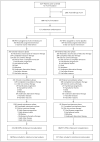Midostaurin plus Chemotherapy for Acute Myeloid Leukemia with a FLT3 Mutation
- PMID: 28644114
- PMCID: PMC5754190
- DOI: 10.1056/NEJMoa1614359
Midostaurin plus Chemotherapy for Acute Myeloid Leukemia with a FLT3 Mutation
Abstract
Background: Patients with acute myeloid leukemia (AML) and a FLT3 mutation have poor outcomes. We conducted a phase 3 trial to determine whether the addition of midostaurin - an oral multitargeted kinase inhibitor that is active in patients with a FLT3 mutation - to standard chemotherapy would prolong overall survival in this population.
Methods: We screened 3277 patients, 18 to 59 years of age, who had newly diagnosed AML for FLT3 mutations. Patients were randomly assigned to receive standard chemotherapy (induction therapy with daunorubicin and cytarabine and consolidation therapy with high-dose cytarabine) plus either midostaurin or placebo; those who were in remission after consolidation therapy entered a maintenance phase in which they received either midostaurin or placebo. Randomization was stratified according to subtype of FLT3 mutation: point mutation in the tyrosine kinase domain (TKD) or internal tandem duplication (ITD) mutation with either a high ratio (>0.7) or a low ratio (0.05 to 0.7) of mutant to wild-type alleles (ITD [high] and ITD [low], respectively). Allogeneic transplantation was allowed. The primary end point was overall survival.
Results: A total of 717 patients underwent randomization; 360 were assigned to the midostaurin group, and 357 to the placebo group. The FLT3 subtype was ITD (high) in 214 patients, ITD (low) in 341 patients, and TKD in 162 patients. The treatment groups were well balanced with respect to age, race, FLT3 subtype, cytogenetic risk, and blood counts but not with respect to sex (51.7% in the midostaurin group vs. 59.4% in the placebo group were women, P=0.04). Overall survival was significantly longer in the midostaurin group than in the placebo group (hazard ratio for death, 0.78; one-sided P=0.009), as was event-free survival (hazard ratio for event or death, 0.78; one-sided P=0.002). In both the primary analysis and an analysis in which data for patients who underwent transplantation were censored, the benefit of midostaurin was consistent across all FLT3 subtypes. The rate of severe adverse events was similar in the two groups.
Conclusions: The addition of the multitargeted kinase inhibitor midostaurin to standard chemotherapy significantly prolonged overall and event-free survival among patients with AML and a FLT3 mutation. (Funded by the National Cancer Institute and Novartis; ClinicalTrials.gov number, NCT00651261 .).
Figures


Comment in
-
Midostaurin in FLT3-Mutated Acute Myeloid Leukemia.N Engl J Med. 2017 Nov 9;377(19):1901. doi: 10.1056/NEJMc1711340. N Engl J Med. 2017. PMID: 29120132 No abstract available.
-
Midostaurin in FLT3-Mutated Acute Myeloid Leukemia.N Engl J Med. 2017 Nov 9;377(19):1901-2. doi: 10.1056/NEJMc1711340. N Engl J Med. 2017. PMID: 29120133 No abstract available.
-
Midostaurin in acute myeloid leukaemia with a FLT3 mutation: Testing the waters.Natl Med J India. 2018 Sep-Oct;31(5):288-290. doi: 10.4103/0970-258X.261188. Natl Med J India. 2018. PMID: 31267996 No abstract available.
References
-
- Döhner H, Weisdorf DJ, Bloomfield CD. Acute myeloid leukemia. N Engl J Med. 2015;373:1136–52. - PubMed
-
- Grimwade D, Hills RK, Moorman AV, et al. Refinement of cytogenetic classification in acute myeloid leukemia: determination of prognostic significance of rare recurring chromosomal abnormalities among 5876 younger adult patients treated in the United Kingdom Medical Research Council trials. Blood. 2010;116:354–65. - PubMed
-
- Döhner H, Estey EH, Amadori S, et al. Diagnosis and management of acute myeloid leukemia in adults: recommendations from an international expert panel, on behalf of the European LeukemiaNet. Blood. 2010;115:453–74. - PubMed
-
- Schnittger S, Schoch C, Kern W, et al. Nucleophosmin gene mutations are predictors of favorable prognosis in acute myelogenous leukemia with a normal karyotype. Blood. 2005;106:3733–9. - PubMed
Publication types
MeSH terms
Substances
Associated data
Grants and funding
- U10 CA180791/CA/NCI NIH HHS/United States
- U10 CA180888/CA/NCI NIH HHS/United States
- U10 CA180836/CA/NCI NIH HHS/United States
- U10 CA077651/CA/NCI NIH HHS/United States
- U10 CA180820/CA/NCI NIH HHS/United States
- U10 CA180882/CA/NCI NIH HHS/United States
- U10 CA031946/CA/NCI NIH HHS/United States
- U10 CA180850/CA/NCI NIH HHS/United States
- U10 CA180821/CA/NCI NIH HHS/United States
- U10 CA077658/CA/NCI NIH HHS/United States
- U10 CA032291/CA/NCI NIH HHS/United States
- U10 CA180867/CA/NCI NIH HHS/United States
- U10 CA033601/CA/NCI NIH HHS/United States
- U10 CA180861/CA/NCI NIH HHS/United States
- U10 CA041287/CA/NCI NIH HHS/United States
- P30 CA016058/CA/NCI NIH HHS/United States
LinkOut - more resources
Full Text Sources
Other Literature Sources
Medical
Miscellaneous
